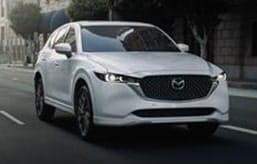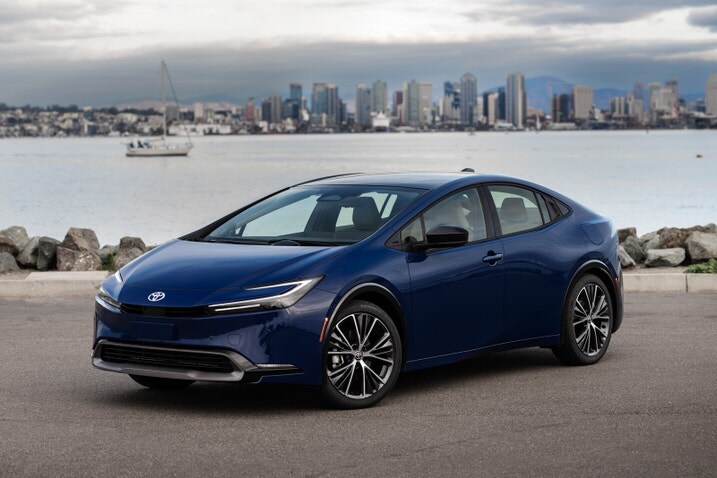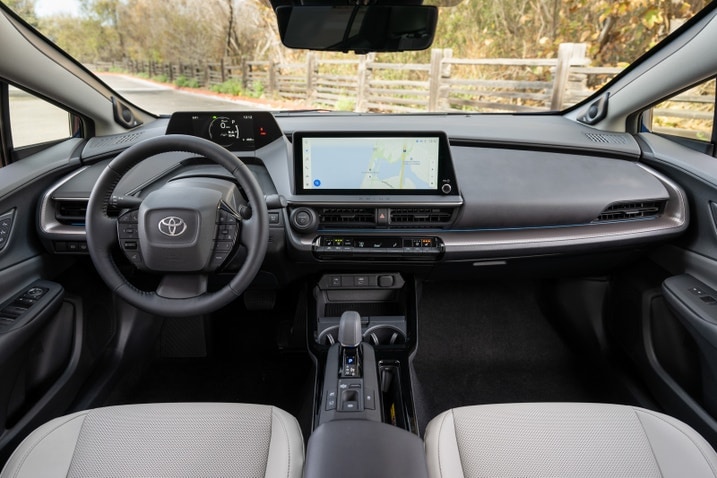- New, far less dorky exterior styling
- More powerful engine/motor combo
- Cabin gets a serious tech upgrade and more conventional styling
- Launches the fifth Prius generation for 2023
First Drive: 2023 Toyota Prius Puts a Priority on Style, But at What Cost?
Prius gets a striking new look, but passenger and cargo space take a hit
The Toyota Prius is many things — efficient, sensible and, with more recent examples, quite roomy — but desirable (and, arguably, good-looking), it is not. At least, until now. Toyota pulled the wraps off the totally redesigned 2023 Prius on the eve of the LA Auto Show, and for once, the eco warrior's favorite hybrid doesn't look like an egg or rejected Gundam character. But the car's new look does force some compromises, which we discovered on our first drive and subsequent week spent with the hybrid.
The disco spaceship styling is joined by significant enhancements to the Prius' powertrain and cabin. The last Prius made a measly 121 horsepower, but a larger gas engine and more powerful electric motors bump that number up to nearly 200 horsepower. No longer will the Prius be synonymous with lethargic acceleration. Here's everything we know.
What's under the Prius' hood?
Like its predecessors, the Prius' powertrain pairs a four-cylinder engine with an electric motor. The engine grows in displacement from 1.8 to 2.0 liters, but even more notable is that the nickel hydride battery pack is finally replaced by a more advanced lithium-ion unit. That means more energy density and a smaller, lighter pack.
In practical terms, these improvements mean that the 2023 Toyota Prius gets a huge bump in power. Last year's fourth-generation Prius produced a total of 121 system horsepower between the engine and motor, while the new one makes a healthy 194 hp in front-wheel-drive guise. Opt for all-wheel drive and output climbs to 196 hp. Toyota says the FWD Prius can accelerate from zero to 60 mph in 7.2 seconds, with the AWD version clocking in at 7.0 seconds flat. That's a darn sight quicker than the 10.7-second time managed by FWD versions of the last Prius in Edmunds' testing. The AWD system gets significant enhancements; in the last Prius, the rear motor would only intervene if the front wheels lost traction. Now, the rear motor (which grows from offering 7 hp to 40 hp) helps out when sprinting off the line and when you press the accelerator during highway merges or when passing.
How does the Prius drive?
Though the old Prius was notoriously slow, I have always thought that its initial acceleration was decent in city driving thanks to the electric motor helping it to get started. The new Prius is much the same way; there's a burst of power from the motors/battery to get you going but now instead of petering out, the transition into gas/blended power is smooth and the Prius pulls hard up to highway speeds. Compared to many other compact vehicles, the Prius can now rightly be considered on the quicker side of the spectrum — a development that's surprising to say the least.
The lithium-ion battery doesn't just push out more power; it's also better at taking it in. On a pair of long drives I did in the Prius and on our real-world testing loop where I ran the car in its Normal drive mode, the battery maintained roughly a two-thirds charge level the entire time, meaning that in slower traffic or in the city there was always plenty of juice for some temporary EV driving.
Suspension updates have also changed the Prius for the better. It rides well over broken pavement and has excellent cabin isolation, a big change from the last car where any bumps would make you feel like the car might break apart around you. The steering is still numb, but it does a great job tracking straight and turn-in feels pretty sharp (or sharper than you'd expect in a Prius).
How comfortable is the Prius?
The new front seats are supposed to decrease drive fatigue, and though they don't offer adjustable thigh support they seem to do a good job. The seats are on the firm side but remained comfortable even for three- or four-hour drives.
Things are much less positive when you get to the back seat, however. Legroom has grown, but the Prius' new swept roofline cuts into rear headroom. Passengers over 6 feet tall will find their haircuts getting acquainted with the headliner in short order. The rear door openings have also shrunk, so you have to duck down quite a bit to get into the cabin. Combine this with a lack of rear air vents and compromised sight lines for rear passengers, and those Uber/taxi rides are going to get less comfortable for the next few years.
How's the Prius' interior?
Inside, the styling is more conventional and that means there's no more funky centrally mounted gauge cluster. Instead, the new Prius features a low dash with a touchscreen perched on top. Below the screen is a row of physical HVAC buttons — a welcome inclusion as more manufacturers move to touchscreen-only controls. Toyota die-hards might, in fact, recognize the steering wheel/IP combo as ripped straight from the all-electric bZ4X. This isn't a good thing. The cluster loves to hide right behind the top rim of the steering wheel — the only way I could see it was to drop the wheel down 2-3 inches, and that made finding a comfortable driving position difficult.
Materials have improved, though the Prius won't be confused for anything premium or luxury. There isn't much of a difference in interior quality between the XLE and the Limited, giving the XLE even more appeal. (Both have synthetic leather upholstery.) The placement of the available wireless charging pad is excellent — instead of taking up storage space, it gets its own slot next to the shifter that's easy to reach. There's just one catch: Charging in an enclosed space generates heat so your phone does get pretty hot. Other automakers are starting to add fans or other cooling to these pads and Toyota would benefit from following suit.
Similar to the back seat, the cargo area is not what it used to be. The last Prius offered near-SUV levels of cargo room with 27.4 cubic feet, but that's dropped all the way down to 20.3 cubic feet in the XLE/Limited models we drove. That's still more than a traditional sedan with a trunk, but it's disappointing for the Prius. The cargo opening itself has also shrunk noticeably, making it harder to fit wide items in; for example, a set of golf clubs that was easily swallowed by the last-generation car doesn't fit in the new one.
How's the Prius' tech?
The 2023 model seriously steps up the Prius' tech cred — a necessary step since the current Prius' touchscreen interface is seriously dated. Two sizes are offered: a standard 8-inch screen and a 12.3-inch unit that is optional on the XLE and standard on Limited models. The UI is identical to that on the bZ4X, as well as the new Tundra pickup and Sequoia SUV, with a snappy interface that is much more intuitive and attractive than that on the outgoing model. To that end, the Prius will feature wireless Apple CarPlay and Android Auto as standard equipment. Optional upgrades include a wireless charging pad, Wi-Fi hotspot, an eight-speaker JBL audio system, and creature comforts like heated and ventilated seats and a panoramic roof.
Every 2023 Prius comes with the Toyota Safety Sense 3.0 suite of driving aids, which includes pre-collision warning and braking, lane departure alert, adaptive cruise control and the new Proactive Driving Assist feature, detailed below. Also standard is a blind-spot warning system with rear cross-traffic warning. Front and rear parking sensors with automatic braking are available on the LE and are included when you upgrade to the XLE. Rounding out the list of driving aids are a hands-free parking system and a 360-degree parking camera, both of which are optional on the top-dog Limited.
Toyota has done a great job calibrating these driver aids. The adaptive cruise control accelerates and brakes smoothly, while the lane keeping centers the car well so it's not ping-ponging between the lane lines. Proactive Driving Assist provides subtle hints to the driver, so if traffic in front of you slows the Prius will also begin to decelerate until the driver takes over the braking. It also flashes a subtle LED strip in the dash if traffic in front of you begins to pull away. It'd be easy for a system like this to be overbearing and annoying, but it toes the line of being informative without being pushy perfectly. If only aunts everywhere could take note.
How economical is the Prius?
On our real-world testing loop, our front-wheel-drive Limited tester achieved an observed 52.3 mpg, narrowly beating its EPA-estimated 52 mpg combined mark. That's an impressive figure given the increase in horsepower for the powertrain. Toyota estimates the entry-level LE model will achieve 57 mpg in the EPA's combined cycle — a 1 mpg bump from the last generation's base L Eco trim. Higher trim levels with the larger 19-inch wheels take an mpg hit, down to 52 mpg combined, and opting for all-wheel drive knocks those numbers down by 3 mpg, respectively.
Edmunds says
The 2023 Toyota Prius pulls a magic trick by becoming stylish and quick in one fell swoop — we just wish that those changes hadn't come at the expense of utility.






 by
by